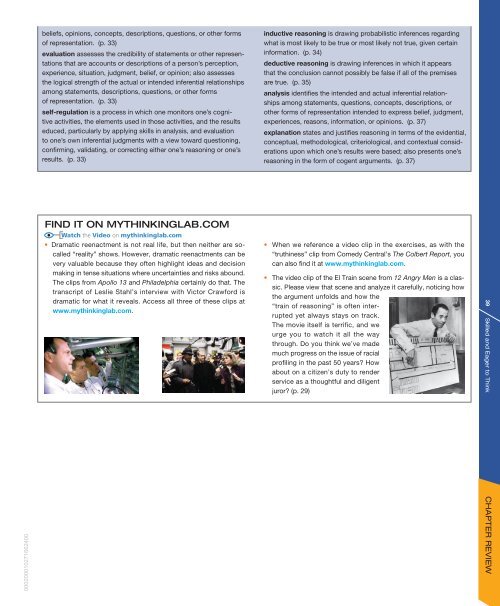Critical Thinking Disposition Self- Rating Form. - Pearson Learning ...
Critical Thinking Disposition Self- Rating Form. - Pearson Learning ...
Critical Thinking Disposition Self- Rating Form. - Pearson Learning ...
You also want an ePaper? Increase the reach of your titles
YUMPU automatically turns print PDFs into web optimized ePapers that Google loves.
eliefs, opinions, concepts, descriptions, questions, or other forms<br />
of representation. (p. 33)<br />
evaluation assesses the credibility of statements or other representations<br />
that are accounts or descriptions of a person’s perception,<br />
experience, situation, judgment, belief, or opinion; also assesses<br />
the logical strength of the actual or intended inferential relationships<br />
among statements, descriptions, questions, or other forms<br />
of representation. (p. 33)<br />
self-regulation is a process in which one monitors one’s cognitive<br />
activities, the elements used in those activities, and the results<br />
educed, particularly by applying skills in analysis, and evaluation<br />
to one’s own inferential judgments with a view toward questioning,<br />
confirming, validating, or correcting either one’s reasoning or one’s<br />
results. (p. 33)<br />
inductive reasoning is drawing probabilistic inferences regarding<br />
what is most likely to be true or most likely not true, given certain<br />
information. (p. 34)<br />
deductive reasoning is drawing inferences in which it appears<br />
that the conclusion cannot possibly be false if all of the premises<br />
are true. (p. 35)<br />
analysis identifies the intended and actual inferential relationships<br />
among statements, questions, concepts, descriptions, or<br />
other forms of representation intended to express belief, judgment,<br />
experiences, reasons, information, or opinions. (p. 37)<br />
explanation states and justifies reasoning in terms of the evidential,<br />
conceptual, methodological, criteriological, and contextual considerations<br />
upon which one’s results were based; also presents one’s<br />
reasoning in the form of cogent arguments. (p. 37)<br />
FIND IT ON MYTHINKINGLAB.COM<br />
000200010271662400<br />
Watch the Video on mythinkinglab.com<br />
• Dramatic reenactment is not real life, but then neither are socalled<br />
“reality” shows. However, dramatic reenactments can be<br />
very valuable because they often highlight ideas and decision<br />
making in tense situations where uncertainties and risks abound.<br />
The clips from Apollo 13 and Philadelphia certainly do that. The<br />
transcript of Leslie Stahl’s interview with Victor Crawford is<br />
dramatic for what it reveals. Access all three of these clips at<br />
www.mythinkinglab.com.<br />
• When we reference a video clip in the exercises, as with the<br />
“truthiness” clip from Comedy Central’s The Colbert Report, you<br />
can also find it at www.mythinkinglab.com.<br />
• The video clip of the El Train scene from 12 Angry Men is a classic.<br />
Please view that scene and analyze it carefully, noticing how<br />
the argument unfolds and how the<br />
“train of reasoning” is often interrupted<br />
yet always stays on track.<br />
The movie itself is terrific, and we<br />
urge you to watch it all the way<br />
through. Do you think we’ve made<br />
much progress on the issue of racial<br />
profiling in the past 50 years How<br />
about on a citizen’s duty to render<br />
service as a thoughtful and diligent<br />
juror (p. 29)<br />
39 Skilled and Eager to Think<br />
CHAPTER REVIEW<br />
Think <strong>Critical</strong>ly, by Peter Facione and Carol Ann Gittens. Published by Prentice Hall. Copyright © 2013 by <strong>Pearson</strong> Education, Inc.

















